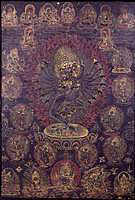
|
Tutelary Deity Hevajra (painting no. 257)
|

View Larger Image |
||||||||||||||
|
Center figure: Hevajra with 8 goddesses, according to the Men-nak luk (system of precepts). Hevajra is in yab-yum form. The father personifies compassion, while the mother personifies wisdom. The 16 arms represent the 16 ways of describing sunyata (emptiness), the 8 faces, the 8 ways towards liberation; the 4 legs, the 4 boundless minds. His 8 right hands which carry animals in skullcups represent the overcoming of the 8 types of diseases. His 8 left hands carry 8 deities, representing the accomplishment of the 8 powers. Hevajra is trampling over the 4 Maras, representing the 4 types of defilement. Upper left corner: the Great Sakya Pandita Kunga Gyaltsen Next: Sonam Tsemo Next: Virupa Upper Center: Vajradhara Next: Sachen Kunga Nyingppo Next: Jetsun Drakpa Gyaltsen Far right corner: Chogyal Phagspa Below left: Jampa Kunga Sangye Tenpa’i Gyaltsen (lama from Derge monastery - this Tangka was probably painted at Derge). Below Right: Naljor Jampal Zangpo (abbot of Ngor Thartse school) Below left: Vajrapani Jungpo Dolje (Bhuttadamara) Below right: Naljorma (Vajrayogini Narokachod) Surrounding Hevajra: the 8 goddesses Bottom Left corner: Namtod sas Next: Palgon chod (Mahakala in the aspect of a Brahmin) Below Center: Kur gyi Gonpo (Tent Mahakala) Right: Dod kham ma (Mahakali) Below right corner: Yellow Zhambala Lama Kunga Rinpoche 12/98 Shri Hevajra and the Eight Goddesses (Tibetan: pal gye pa dor je lha mo gye). The principal Tantric deity of the Sakya School. Semi-wrathful, dark blue in colour with eight faces, sixteen hands and four legs he has placed on each side of the main face three more faces with the eighth situated centrally above, the yellow hair flows upward like flames. The sixteen hands each hold a skullcup. The right hands hold eight different animals and the left hold eight worldly gods. The first pair folded at the heart embrace the consort. Adorned with a crown of skulls, bone ornaments and a necklace of fifty freshly severed heads he has the appearance of being slightly wrathful and slightly peaceful. Standing with the right legs down and the left drawn up in a dancing posture above the four maras, a sun disc and lotus seat, he is completely surrounded by the flames of pristine awareness. The consort vajra Nairatmya, black in colour, has one face and two hands holding a curved knife and skullcup. Adorned with bone ornaments and a necklace of fifty skulls she stands with the right leg down and the left raised to embrace the partner. At the top center is the primordial buddha Vajradhara with Virupa, Sonam Tsemo (1142-1182) and Sakya Pandita (1182-1251) to the left. At the right are Sachen Kunga Nyingpo (1092-1158), Trakpa Gyaltsen (1147-1216) and Chogyal Phagpa (1235-1280). On the left, slightly below, is the lama Sakya Champa Kunga Sangye Gyaltsen, with the right hand performing the mudra of blessing and the left holding a book in the lap, wearing a pandita hat with the lappets folded above. Below is the wrathful bodhisattva Vajrapani Bhutadamara, remover of obstacles, with one face and four hands. On the right side is the lama Naljor Champa Zangpo with the right hand in the mudra of generosity and holding a vase in the lap with the left, wearing a pandita hat with lappets folded above. Below is the tutelary deity Vajrayogini, red, with one face and two hands holding a curved knife and skullcup. Along side Hevajra are two rows of four goddesses, starting from the right are Vetali, Dombini, Ghasmari and Pukkasi and on the left Candali, Cauri, Shavari and Gauri. They each have one face and two hands, various colours, wearing bone ornaments and a necklace of fifty skulls, standing above a corpse, sun and lotus seat. At the bottom center is Panjarnatha Mahakala, very wrathful in appearance, with one face and two hands holding a curved knife and skullcup with a stick placed across the forearms. To the left is Brahmarupa Mahakala, seated, holding a shinbone trumpet and skullcup. In the left corner is the Direction Guardian Vaisravana with one face and two hands holding a victory banner and a jewel spitting mongoose, riding a snow lion. To the right is Shri Devi with one face and four hands holding a sword, skullcup, spear and trident, riding a mule. In the right corner is the god of wealth Jambhala, yellow, with one face and two hands holding a bijapuraka fruit and a mongoose. Shri Hevajra is a tutelary deity of the Anuttarayoga Non-dual classification. From the many different types of appearance this form is known as the 'Essence Hevajra' as taught in the root Tantra. Lineage: Vajradhara, Vajra Nairatmya, Virupa, Krishnapa, Damarupa, Avadhutipa, Gayadhara, Drogmi Lotsawa, Seton Kunrig, Shangton Chobar, Sachen Kunga Nyingpo (1092-1158), etc. The painting style is called 'black scroll' (nag thang); the background is black and the deities are drawn as an outline, often in gold, with more or less colour and detail added at the discretion of the artist. The names of the lamas at the top and the row of deities along the bottom are written in fine gold letters beneath each. J.Watt 6-98
|
|||||||||||||||
Photographed Image Copyright © 1999 Shelley & Donald Rubin Foundation
|
|
| |
Next Image |